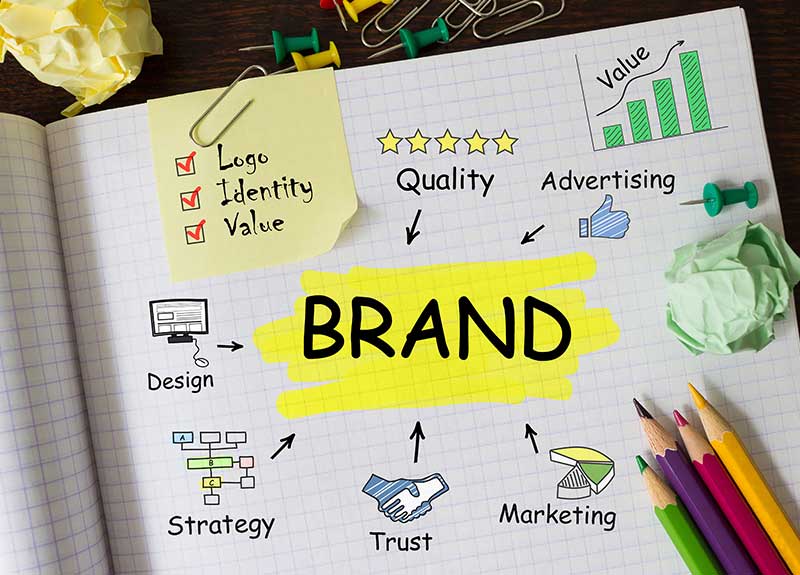Brand Identity Design
Brand Identity Design takes centre stage in the dynamic landscape of business, where first impressions wield immense influence. Serving as the visual representation of a company’s values, mission, and personality, it is a cornerstone of successful business strategy. Let’s delve into the core elements that make this design discipline an indispensable aspect of any thriving enterprise.
In the ever-evolving realm of business, where the digital and physical converge, the importance of a compelling and distinctive Brand Identity Design cannot be overstated. This multifaceted discipline goes beyond mere aesthetics, serving as the visual embodiment of a company’s core values, mission, and unique personality. As the first point of contact with the audience, it holds the power to leave a lasting impression, shape perceptions, and foster a connection that transcends products or services. In this era of heightened competition and discerning consumers, exploring the nuances of Brand Identity Design becomes imperative to understand how it not only reflects but defines the essence of a brand in the global marketplace.
The Building Blocks of Brand Identity: Logo Design
- Definition: A logo is the visual cornerstone of a brand’s identity. It’s a symbol that encapsulates the essence and values of the brand.
- Importance: Logos are crucial for instant brand recognition. A well-designed logo communicates professionalism and establishes trust.
Colour Palette
- Definition: The strategic selection and use of colours that represent the brand. Colours evoke emotions and influence consumer perceptions.
- Importance: Consistent colour usage fosters recognition, establishes a brand’s personality, and enhances visual appeal.
Typography: Company Image
- Definition: The choice of fonts and the arrangement of text to convey a brand’s tone, personality, and style.
- Importance: Typography contributes to brand identity by shaping the visual language and creating a cohesive and recognizable look.
Visual Elements: Brand Appearance
- Definition: The consistent use of imagery, graphics, and other visual elements that align with the brand’s identity.
- Importance: Visual consistency reinforces brand recognition and helps convey the brand’s story and values.
Brand Guidelines: Visual Recognition
- Definition: A comprehensive set of rules and standards that dictate how the brand’s identity elements should be used across various mediums.
- Importance: Brand guidelines ensure consistency, helping to maintain a unified and coherent brand image.
Brand Storytelling: Corporate Persona
- Definition: The art of using the brand’s identity elements to tell a cohesive and compelling narrative about the brand’s history, values, and vision.
- Importance: Effective brand storytelling creates an emotional connection with the audience, making the brand more memorable.
Target Audience Alignment: Brand Symbolism
- Definition: Tailoring the Corporate Image to resonate with the preferences, values, and aspirations of the target audience.
- Importance: Aligning with the target audience ensures that the brand is relatable and appealing to the intended consumer base.
Adaptability for Growth: Visual Representation
- Definition: Designing a Company Persona that can evolve and scale alongside the business’s growth and changes.
- Importance: An adaptable Branding Identity remains relevant, avoiding the need for frequent redesigns as the business expands.
Competitive Analysis: Brand Presentation
- Definition: Studying and understanding the brand identities of competitors to identify unique elements and opportunities for differentiation.
- Importance: A thorough competitive analysis informs the design process, helping the brand stand out in a crowded market.
Online and Offline Integration: Business Persona
- Definition: Ensuring that the Visual Branding is seamlessly integrated across both digital and traditional offline channels.
- Importance: Consistent integration enhances brand visibility and recognition in diverse contexts, catering to a wide audience.
A robust Brand Identity Design encompasses these elements, forming a cohesive visual language that not only distinguishes a brand but also communicates its values, resonates with the audience, and contributes to long-term success in the competitive business landscape.
The Impact of Brand Identity Design
Brand Identity Design is a pivotal force that extends far beyond aesthetics, exerting a profound impact on a brand’s perception, recognition, and overall success. Here’s a closer look at the multifaceted impact it wields:
Recognition and Recall: Corporate Image
- Impact: A well-crafted Brand Representation fosters instant recognition. Logos, colours, and visual elements create a distinctive imprint in the consumer’s memory.
- Outcome: Increased recall leads to a stronger brand presence and preference when consumers make purchasing decisions.
Trust and Credibility: Identity Design
- Impact: Consistent Business Identity signals reliability and professionalism. It establishes trust, essential for building long-lasting relationships with consumers.
- Outcome: Trustworthy brands are more likely to attract and retain customers, fostering brand loyalty.
Competitive Differentiation: Logo and Branding
- Impact: Unique brand elements set a brand apart from competitors. A distinctive identity helps consumers differentiate between similar products or services.
- Outcome: Competitive advantage is gained by creating a memorable and unique brand presence in the market.
Emotional Connection: Branding Identity
- Impact: Brand Image design, especially through storytelling and visual elements, forges emotional connections with consumers.
- Outcome: Emotional resonance leads to brand loyalty, with consumers choosing brands that align with their values and evoke positive feelings.
Brand Consistency: Brand Representation
- Impact: A well-defined Visual Identity ensures consistency across all touchpoints, reinforcing a cohesive brand image.
- Outcome: Consistency enhances brand recall, prevents confusion, and strengthens the overall impact of brand messaging.
Adaptability and Growth: Business Identity
- Impact: An adaptable Corporate Branding design accommodates the brand’s growth, changes, and evolving market trends.
- Outcome: Brands that evolve seamlessly maintain relevance, appeal to changing demographics, and sustain long-term success.
Consumer Engagement: Brand Image
- Impact: Engaging brand visuals and identity elements capture consumer attention in a saturated market.
- Outcome: Increased engagement leads to higher brand visibility, fostering a sense of community and participation among consumers.
Perceived Value: Visual Identity
- Impact: A strong brand identity contributes to the perception of a brand’s value, often allowing for premium pricing.
- Outcome: Consumers are willing to pay more for products or services associated with a brand they perceive as valuable and trustworthy.
Online and Offline Cohesion: Brand Appearance
- Impact: A unified brand identity across online and offline platforms ensures a seamless brand experience.
- Outcome: Cohesiveness reinforces brand identity, allowing consumers to interact with the brand consistently regardless of the medium.
Brand Loyalty: Business Persona
- Impact: The emotional connection and positive associations fostered by brand identity design cultivate brand loyalty.
- Outcome: Loyal customers are more likely to repeat purchases, advocate for the brand, and withstand competitive pressures.
In essence, the impact of Brand Identity Design transcends aesthetics, playing a pivotal role in shaping consumer perceptions, driving engagement, and ultimately contributing to the sustained success and resilience of a brand in a dynamic marketplace.
Crafting Your Brand’s Visual Story: Understanding Your Audience
Tailoring brand identity to resonate with the target audience ensures that it connects on a deeper level.
Adaptability for Growth: Identity Design
A scalable brand identity accommodates growth and evolution, ensuring relevance as the business expands.
Investing in Success: The ROI of Effective Brand Identity Design
In conclusion, brand identity design is an investment in a company’s success. It is the visual language that speaks to the audience, conveying trust, reliability, and uniqueness. As businesses navigate the competitive landscape, a thoughtfully crafted brand identity becomes a powerful tool for making a lasting impact. It’s not just about design; it’s about telling a compelling visual story that resonates with the audience and stands the test of time.






